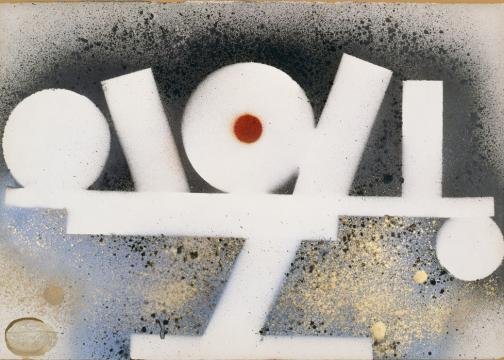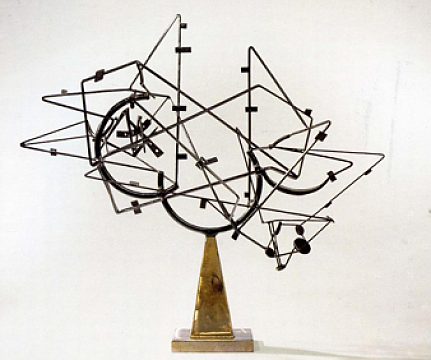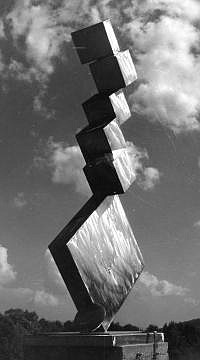 Facebook
Facebook
 X
X
 Instagram
Instagram
 TikTok
TikTok
 Youtube
Youtube

Some clichés smell okay, others stink. Whenever I hear a California enthusiast hyperventilating about how the West Coast is culturally “cutting edge” and so “out there,” I remember that the last time David Smith (the most important and grandest 20th-century American sculptor) had a major exhibition in California was in Los Angeles in 1965. It wasn’t planned as a memorial exhibition, but that’s what it became when Smith died in a car accident earlier that year. He was 51 years old.
If you go East this summer, drive northwest from New York City into the Hudson Highlands to Storm King Center, a smallish museum set among 500 acres landmarked by works by Alexander Calder, Mark di Suvero, and other major sculptors of the past hundred years. It’s not so much a sculpture garden as a sculpture estate, and the estate is owned, so to speak, by 13 works by David Smith. To see these in the open air, in varied weathers, is to see them more or less as Smith himself did in the fields outside his workshop in Bolton Landing, way north of Storm King on the western shore of Lake George. Hilton Kramer years ago described Bolton Landing as “a machine shop in a landscape,” which nails the mechanical-bucolic quality of some of Smith’s work. As a kid, he was either playing around rail yards and factories or fields and creeks. If you’re not going East, consider a pilgrimage to David Smith: Cubes and Anarchy, a thrilling selection of Smith’s sculptures, paintings, and drawings currently at the Los Angeles County Museum of Art. Anybody with a passion for the sculptural imagination will want to see this exhibition.
That includes machinists (if there are any left), metalworkers, inventors, and mechanical engineers. Smith grew up middle class — his father was an engineer-inventor, his great-grandfather a blacksmith — but during a summer job following his first and only year of college, he learned to solder and spot-weld at a Studebaker factory and would later say that his geometric, non-representational forms owed everything to “gears, crossmembers, and brackets.” As his welding skills developed, so did his political affinity for the workingmen who were his first teachers. (First teasers, too: his coworkers, old-style beer-and-shot guys, made quick work of the wispy, bohemian goatee Smith sported on the job.) For the rest of his life, Smith identified himself as a blue-collar artist (he called Bolton Landing “Terminal Iron Works”) and unrepentant leftie, and he produced a body of work unequaled for its industrial-pastoral lyricism.
The LACMA exhibition is a generous sampler that walks us through virtually every stage of Smith’s development, beginning at the end, with the austerely enchanting stainless-steel cubes, slabs, and cylinders of the Cubi series, their surfaces burnished with the whorling, sliding, serpentine sweeps of a circular sander, back through the Zig and Tanktotem works of the 1950s and early 1960s, then to the earlier work where we see Smith’s furious curiosity about sculpture’s possibilities, from small-scaled, reductive, purely abstract “constructions” to ascetic vertical humanesque works (like the 1954 Sitting Printer, whose torso is a type-case) and loose air-maze bundles of looping steel cables that bespeak Smith’s lifelong conviction that sculpture is “drawing in space.” The only things I miss are the chunky, hefty ode-to-machine-shop pieces of the 1950s that utilize gigantic wrenches, gears, pliers, scrap, gears, connecting rods, and just about anything else Smith found that he could absorb into his form vocabulary.
Smith was born in Indiana (the Studebaker plant was in South Bend) in 1906 and by 1923 was in New York, where he studied painting and drawing at the Art Students League. During the New York years, he was exposed to Cubism and Russian Constructivism and experimented with punching a third, relief-like dimension into his paintings. He was also soaking up progressive politics, when one could still speak of a proletariat and a workers’ revolution. It was during this period that Smith learned what he called “cubes and anarchy,” and he would go on to make art that compounded an exquisite cubist-abstractionist sensibility with the energy and robustness of heavy-duty materials. No artist’s originality is original. Smith was quick to declare the critical influence of Picasso’s welded sculpture and Picasso’s own mentor, the great Catalan iron-welding artist Julio González (1876–1942), who learned his craft in a Renault factory near Paris. In 1932, Smith bought welding equipment and set about expanding the language created by González and Picasso. By the late 1930s, he was producing his brutally sardonic, anti-war bronze medallions, Medals for Dishonor.

The only difference between painting and sculpture, Smith believed, was “one element of dimension.” For him, drawing and arc-welding both depended on incremental additions. He was an adventurer and would try anything. For Steel Drawing, I, he used a steel slab as a draftsman uses paper; his pen was an oxy-acetylene cutting torch. The networks of angular lines and ocular points look like fantastical constellations, and the curators have installed it just a few steps away from his rapturous gyroscopic Starcage, an airy three-dimensional weave of wiry oval hoops. Smith possessed a machinist’s feeling for massive materials and a magical imagination. We see its transformative power in Cubi 4, a large abstract work whose leaning “posture” and buoyant, tilting fleetingness were modeled on a photograph Smith took of his daughter Becca running around with a plate in her hands.
Like Brancusi, Smith took many photographs. He liked to “pose” his works in the huge doorway of his Bolton Landing workshop — they look like titanic greeters to the shop’s magisterial contents, or like lookouts overseeing the nature that empowered Smith’s imagination. Some of the photos are giveaways: one, of a ship’s steam stacks, winches, ropes, and pipe railings, is a formal index to Smith’s work; and a Bolton Landing photo of vigilant “sentinels” (trimmed and capped and footed by snow) standing next to a birch tree perfectly expresses how the imagination models from nature, in however abstract a manner, then restores an intensified nature, transformed, to our lives. Seeing Smith’s works in their proper places — the wild places of studio and the natural world — makes me think that he wanted to find fresh, adamic ways of greeting the world, formally and politically. Even in a museum setting, you can sense how one man’s imagination takes what history and the reality of his moment give him and turns it into a passion for existence and the work of existence.
The exhibition concludes with drawings and paintings. The drawings are a formal laboratory, and it’s no surprise that many have a celebratory, sexualized energy. We also see the continuity between his flat paintings and the geometric fields of paint he applied to a lot of his sculptures. Some of the pictures are made with automobile enamel spray paint. The aerated, gaseous compositions recall one of his formative models, Kandinsky, who in the 1920s and 1930s made atomizer-spray drawings, but they also remind me that one technique used by the artists who decorated cave walls at Chauvet 32,000 years ago was to blow pigment through tubes of hollowed animal bone or their own cupped hands. Smith’s work arcs between such prehistoric ceremonialism (or decoration: the jury’s still out on that) and modern manufacturing. Every piece in Smith’s Tanktotem series incorporates a boiler-tank drumhead, and the “totem” component expresses communal animism.

The ravishing surprise of the exhibition for me is the way the sanded surfaces of the Cubi’s solid stainless-steel blocks and logs teem with actions of light. The gallery illumination creates ripples, runners, and flashings that seem to move inside the steel, as if a hidden life is being briefly, uncannily exposed. The whorls and jags where the sander has “drawn” on the steel become, as you move around the work, cascading necklaces of pearly light, boas and ribbons and chevrons and wings that won’t stay still. They give mass an unearthly transparency. Smith gets it all, both the gravity and the lightness of being. ■
David Smith: Cubes and Anarchy is on view at the Los Angeles County Museum of Art until July 24. 5905 Wilshire Boulevard, 323-857-6000, [email protected].


Some clichés smell okay, others stink. Whenever I hear a California enthusiast hyperventilating about how the West Coast is culturally “cutting edge” and so “out there,” I remember that the last time David Smith (the most important and grandest 20th-century American sculptor) had a major exhibition in California was in Los Angeles in 1965. It wasn’t planned as a memorial exhibition, but that’s what it became when Smith died in a car accident earlier that year. He was 51 years old.
If you go East this summer, drive northwest from New York City into the Hudson Highlands to Storm King Center, a smallish museum set among 500 acres landmarked by works by Alexander Calder, Mark di Suvero, and other major sculptors of the past hundred years. It’s not so much a sculpture garden as a sculpture estate, and the estate is owned, so to speak, by 13 works by David Smith. To see these in the open air, in varied weathers, is to see them more or less as Smith himself did in the fields outside his workshop in Bolton Landing, way north of Storm King on the western shore of Lake George. Hilton Kramer years ago described Bolton Landing as “a machine shop in a landscape,” which nails the mechanical-bucolic quality of some of Smith’s work. As a kid, he was either playing around rail yards and factories or fields and creeks. If you’re not going East, consider a pilgrimage to David Smith: Cubes and Anarchy, a thrilling selection of Smith’s sculptures, paintings, and drawings currently at the Los Angeles County Museum of Art. Anybody with a passion for the sculptural imagination will want to see this exhibition.
That includes machinists (if there are any left), metalworkers, inventors, and mechanical engineers. Smith grew up middle class — his father was an engineer-inventor, his great-grandfather a blacksmith — but during a summer job following his first and only year of college, he learned to solder and spot-weld at a Studebaker factory and would later say that his geometric, non-representational forms owed everything to “gears, crossmembers, and brackets.” As his welding skills developed, so did his political affinity for the workingmen who were his first teachers. (First teasers, too: his coworkers, old-style beer-and-shot guys, made quick work of the wispy, bohemian goatee Smith sported on the job.) For the rest of his life, Smith identified himself as a blue-collar artist (he called Bolton Landing “Terminal Iron Works”) and unrepentant leftie, and he produced a body of work unequaled for its industrial-pastoral lyricism.
The LACMA exhibition is a generous sampler that walks us through virtually every stage of Smith’s development, beginning at the end, with the austerely enchanting stainless-steel cubes, slabs, and cylinders of the Cubi series, their surfaces burnished with the whorling, sliding, serpentine sweeps of a circular sander, back through the Zig and Tanktotem works of the 1950s and early 1960s, then to the earlier work where we see Smith’s furious curiosity about sculpture’s possibilities, from small-scaled, reductive, purely abstract “constructions” to ascetic vertical humanesque works (like the 1954 Sitting Printer, whose torso is a type-case) and loose air-maze bundles of looping steel cables that bespeak Smith’s lifelong conviction that sculpture is “drawing in space.” The only things I miss are the chunky, hefty ode-to-machine-shop pieces of the 1950s that utilize gigantic wrenches, gears, pliers, scrap, gears, connecting rods, and just about anything else Smith found that he could absorb into his form vocabulary.
Smith was born in Indiana (the Studebaker plant was in South Bend) in 1906 and by 1923 was in New York, where he studied painting and drawing at the Art Students League. During the New York years, he was exposed to Cubism and Russian Constructivism and experimented with punching a third, relief-like dimension into his paintings. He was also soaking up progressive politics, when one could still speak of a proletariat and a workers’ revolution. It was during this period that Smith learned what he called “cubes and anarchy,” and he would go on to make art that compounded an exquisite cubist-abstractionist sensibility with the energy and robustness of heavy-duty materials. No artist’s originality is original. Smith was quick to declare the critical influence of Picasso’s welded sculpture and Picasso’s own mentor, the great Catalan iron-welding artist Julio González (1876–1942), who learned his craft in a Renault factory near Paris. In 1932, Smith bought welding equipment and set about expanding the language created by González and Picasso. By the late 1930s, he was producing his brutally sardonic, anti-war bronze medallions, Medals for Dishonor.

The only difference between painting and sculpture, Smith believed, was “one element of dimension.” For him, drawing and arc-welding both depended on incremental additions. He was an adventurer and would try anything. For Steel Drawing, I, he used a steel slab as a draftsman uses paper; his pen was an oxy-acetylene cutting torch. The networks of angular lines and ocular points look like fantastical constellations, and the curators have installed it just a few steps away from his rapturous gyroscopic Starcage, an airy three-dimensional weave of wiry oval hoops. Smith possessed a machinist’s feeling for massive materials and a magical imagination. We see its transformative power in Cubi 4, a large abstract work whose leaning “posture” and buoyant, tilting fleetingness were modeled on a photograph Smith took of his daughter Becca running around with a plate in her hands.
Like Brancusi, Smith took many photographs. He liked to “pose” his works in the huge doorway of his Bolton Landing workshop — they look like titanic greeters to the shop’s magisterial contents, or like lookouts overseeing the nature that empowered Smith’s imagination. Some of the photos are giveaways: one, of a ship’s steam stacks, winches, ropes, and pipe railings, is a formal index to Smith’s work; and a Bolton Landing photo of vigilant “sentinels” (trimmed and capped and footed by snow) standing next to a birch tree perfectly expresses how the imagination models from nature, in however abstract a manner, then restores an intensified nature, transformed, to our lives. Seeing Smith’s works in their proper places — the wild places of studio and the natural world — makes me think that he wanted to find fresh, adamic ways of greeting the world, formally and politically. Even in a museum setting, you can sense how one man’s imagination takes what history and the reality of his moment give him and turns it into a passion for existence and the work of existence.
The exhibition concludes with drawings and paintings. The drawings are a formal laboratory, and it’s no surprise that many have a celebratory, sexualized energy. We also see the continuity between his flat paintings and the geometric fields of paint he applied to a lot of his sculptures. Some of the pictures are made with automobile enamel spray paint. The aerated, gaseous compositions recall one of his formative models, Kandinsky, who in the 1920s and 1930s made atomizer-spray drawings, but they also remind me that one technique used by the artists who decorated cave walls at Chauvet 32,000 years ago was to blow pigment through tubes of hollowed animal bone or their own cupped hands. Smith’s work arcs between such prehistoric ceremonialism (or decoration: the jury’s still out on that) and modern manufacturing. Every piece in Smith’s Tanktotem series incorporates a boiler-tank drumhead, and the “totem” component expresses communal animism.

The ravishing surprise of the exhibition for me is the way the sanded surfaces of the Cubi’s solid stainless-steel blocks and logs teem with actions of light. The gallery illumination creates ripples, runners, and flashings that seem to move inside the steel, as if a hidden life is being briefly, uncannily exposed. The whorls and jags where the sander has “drawn” on the steel become, as you move around the work, cascading necklaces of pearly light, boas and ribbons and chevrons and wings that won’t stay still. They give mass an unearthly transparency. Smith gets it all, both the gravity and the lightness of being. ■
David Smith: Cubes and Anarchy is on view at the Los Angeles County Museum of Art until July 24. 5905 Wilshire Boulevard, 323-857-6000, [email protected].
Comments